The Richtmyer-Meshkov instability of a'V'shaped air/helium interface subjected to a weak shock
Zhigang Zhai,Xisheng Luo,Ping DongAdvanced Propulsion Laboratory,Department of Modern Mechanics,University ofScience and Technology of China,230026 Hefei,China
Letter
The Richtmyer-Meshkov instability of a'V'shaped air/helium interface subjected to a weak shock
Zhigang Zhai?,Xisheng Luo,Ping Dong
Advanced Propulsion Laboratory,Department of Modern Mechanics,University ofScience and Technology of China,230026 Hefei,China
H I G H L I G H T S
.A novelmethod using the soap film technique is developed to create a discontinuous'V'shaped air/helium interface for Richtmyer-Meshkov instability (RMI)study.
.The reduction factor is applied to the linear model and the modified linear modelis capable to predict the width growth rate of interface with high initialamplitudes.
.The initialgrowth rate of interface width is a non-monotonous function of the initial vertex angle,which is found for the first time in a heavy/light interface configuration.
A R T I C L E I N F O
Article history:
Received 31 May 2016
Accepted 30 June 2016
Available online 22 July 2016
Richtmyer-Meshkov instability V shaped interface High-speed schlieren photography
The Richtmyer-Meshkov instability ofa'V'shaped air/helium gaseous interface subjected to a weak shock wave is experimentally studied.A soap film technique is adopted to create a'V'shaped interface with accurate initial conditions.Five kinds of'V'shaped interfaces with different vertex angles are formed to highlight the effects of initial conditions on the flow characteristics.The results show that a spike is generated after the shock impact,and grows constantly with time.As the vertex angle increases,vortices generated on the interface become less noticeable,and the spike develops less pronouncedly.The linear growth rate ofinterface width after compression phase is estimated by a linear modeland a revised linear model,and the latterisproven to be more effective forthe interface with high initialamplitudes.The linear growth rate of interface width is,for the first time in a heavy/light interface configuration,found to be a non-monotonous function ofthe initialperturbation amplitude-wavelength ratio.
?2016 The Authors.Published by Elsevier Ltd on behalfof The Chinese Society of Theoreticaland Applied Mechanics.This is an open access article under the CC BY-NC-ND license(http:// creativecommons.org/licenses/by-nc-nd/4.0/).
Richtmyer-Meshkov instability(RMI)[1,2]arises when an interface with perturbations between two different fluids is impulsively impacted by a shock wave.Initially,the instabilities develop rapidly and reach a nonlinear state where the mixing layer between light and heavy components exhibits characteristic mushroom-shaped bubbles and spikes.The flow development is associated with transition and turbulentmixing.An understanding of this mechanism for the amplification of the initial interface perturbations and the associated mixing process is important in many areas of scientific research,such as inertial confinement fusion[3]and supersonic combustion[4].
The dominant mechanism governing the hydrodynamic instability is the baroclinic vorticity deposition which results from the misalignment ofdensity and pressure gradients.The shape and feature of the interface determine the density gradient,therefore,a highly accurate initial interfacial condition is crucial for investigating the development of the instability.An inclined interface provides good conditions for the shock refraction study because of the unique feature that the incident angle is constant along the interface edge.The refraction of a planar shock at an inclined interface has been studied extensively[5,6].However,the postshock flow field of an inclined interface is seldom investigated experimentally.The work using organic films[7]and nitrocellulose membrane with a support[8]provided situations for the RMI study of the inclined interface.Unfortunately,the fragments of the nitrocellulose membrane and the support could have unfavorable effects on the evolution of flow field.Recently,a series of studies on the RMIof a membraneless inclined interface have been reported [9-11].In their experiments[9],the inclined interface is a diffusive one which will reduce the growth rate of perturbation,and only light/heavy case was investigated.In our previous work[12],a soapfilm technique was adopted to form five kinds of discontinuous 'V'shaped air/SF6interface with different amplitude-wavelength ratios.The influence of amplitude-wavelength ratio on interface width variation was investigated,and some models were tested. It was found that the interface width growth rate is a nonmonotonous function of the initial amplitude-wavelength ratio, providing an indirect experimental evidence for the numerical results of Dellet al.[13].For a light/heavy case,the perturbation amplitude increases immediately after the compression stage,while for a heavy/light one,the phase reversal needs special consideration.

Fig.1.The interface formation method.(a),(b)The arrangementofthe fine needles around the vertex for different cases.(c)The interface formation process.(d)The images of the interface formed.
In this work,a similar interface formation method to the previous work[12]is adopted to create a'V'shaped heavy/light interface.The interface formed is discontinuous and has no supports such that the unwanted effects of gas diffusion and support can be removed.Note that an inclined interface is equivalent to half of the'V'shaped interface,the boundary effects can also be reduced. Therefore,it is expected that the experiments could provide a reliable resultofthe RMIofthe inclined interface subjected to a planar shock.
The'V'shaped interface is created by a soap film technique in which fine needles are introduced as angular vertexes to connect adjacent sides of soap films.As indicated in Fig.1(a), (b),two acrylic plates(3 mm in thickness)with a distance of 20 mm are first adopted to create the interface framework.Then fine needles(0.2 mm in diameter)are introduced at the vertex where the number of fine needle is dependent upon the angle between two adjacent soap films.The effects of the tube wall on the interface evolution could be largely reduced since the 'V'shaped interface boundaries contact the tube wall through another interface(the flat part)which will not be considered in experiments.A rectangular frame with the soap film on its surface is pulled along the interface framework,as shown in Fig.1(c),and then a'V'shaped interface can be formed.The schlieren image of the'V'shaped interface formed is presented in Fig.1(d)fromwhich the initial flow field can be clearly identified.In this work,five 'V'shaped interfaces with different vertex angles(θ=60°,90°, 120°,140°,and 160°)are considered by fixing the initialinterface width(W0)to 80 mm.For the current interface configuration,the initial amplitude(a0)is defined to be the total extent of the'V' shaped interface,which is twice the usual amplitude for a singlemode interface.Accordingly,the wavelength(λ)of the'V'shaped interface is taken asλ=2W0.The relation among the a0,λ,and θis given by a0/λ=1/4 tan(θ/2).As can be found in Table 1,a linear initial condition is satisfied only for the cases ofθ=160° and 140°(a0/λ<0.1).

Table 1 Experimentalparameters for allcases.
Experiments are conducted in the same horizontal shock tube as in our previous work[14].The shock tube consists of a 1.7 m long driver section,a 3.9 m long driven section and a 1.0 m long test section.The rectangular cross-section of the test section is 155 mm X26 mm.The incident shock Mach number(M)measured by piezoelectric transducers is 1.20±0.01.Illuminated by a DC-regulated light source(DCR III,SCHOTT North America,Inc),the postshock flow field is recorded by a schlieren photography with a high-speed video camera(FASTCAM SA5,Photron Limited).The detailed experimental parameters are listed in Table 1.Prior to experiment,air at the right side of interface should be removed and replaced by the test gas helium.Once the concentration of helium meets the requirement,the framework with a formed'V' shaped interface is inserted into the test section slowly,and the experiment can be performed.
The evolutions of the shocked interfaces are shown in Fig.2 where the cases ofθ= 90°and 140°are omitted because of the similarity to the cases ofθ=60°and 160°,respectively.For all cases,the moment when the incident shock meets the vertex of the interface is defined as the initial time.When an incident shock encounters an inclined air/helium interface,a transmitted shock wave is generated in helium gas,simultaneously,a reflected wave propagates back into air.Compressed by the incident shock, the interface amplitude begins to decrease,and an obvious spike emerges at t=266μs forθ=60°due to the baroclinic vorticity deposition.With the spike movement,phase reversal,the specific feature of a heavy/light interface configuration,occurs(t= 446μs).As time proceeds,the spike grows in scale continuously and many smallvortices presentatthe interface,as can be found at t=446-466μs forθ=60°.At late times,the spike becomes the dominant feature in the flow field.Forθ=60°,the soap droplets separate from the interface at late stage.For a heavy/light interface,the velocity induced by vorticity is in the same direction as the postshock flow velocity.Therefore,more vorticity is deposited on the interface forthe caseswith smallvertex angles,resulting in a faster movement ofthe air/heliuminterface than the soap droplets. As the vertex angle increases,less vorticity is created on the interface.Consequently,the spike becomes less pronounced and the interface distorts less remarkably.Besides,due to the smallvorticity amplitude,additional velocity of the interface induced by the vorticity is limited,and the smalldifference in the velocities between the interface and the soap droplets causes the coupling ofthem,as indicated in the cases ofθ=120°and 160°.
After the phase reversal,the interface width begins to grow from the minimum.For a heavy/lightcase,Meyerand Blewett[15] proposed a linear model(MB model)to estimate the initiallinear growth rate v0.The MB model can be expressed as

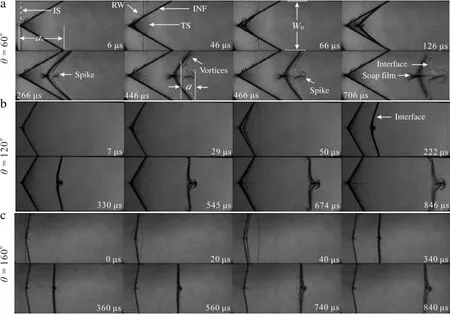
Fig.2.Experimental schlieren sequences showing the evolution of a shocked air/helium interface for(a)θ=60°,(b)θ=120°,and(c)θ=160°.IS,incident shock;INF, initialinterface;TS,transmitted shock;RW,reflected wave;a0,initialinterface amplitude;a,evolving interface amplitude;W0,halfofinterface wavelength.

Table 2 The reduction factor R and the initiallinear growth rate v0calculated by the RMB model[16].

The value ofthe reduction factor R is different for each vertex angle θ,and is listed in Table 2.Comparison of the experimental results with the predictions from the RMB modelis shown in Fig.4.Good agreements are reached for both the smallinitialamplitudes and high initial amplitudes,illustrating the effectiveness of the RMB modelfor capturing the width linear growth rate of interface with high initialamplitudes.
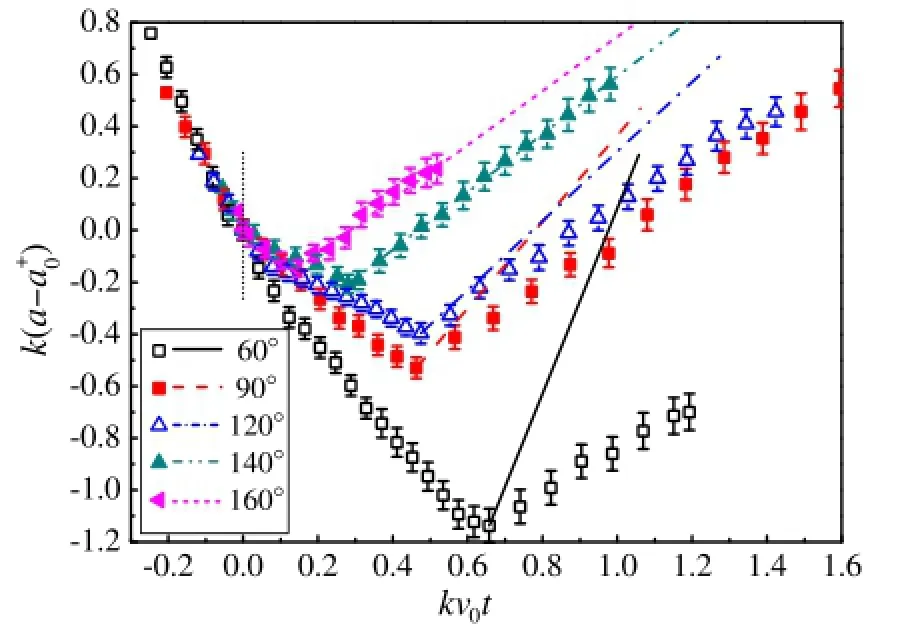
Fig.3.(Color online)Comparison ofmixing width extracted fromthe experimental results with the MB model[15]after the phase reversal.The vertical dotted line means the time ofthe shock leaving the interface.
From Table 2,one can find that the interface width growth rate experiences an increase and then a decrease as the vertex angle increases.Dell et al.[13]indicated in their numerical work on a shocked sinusoidal air/SF6interface that for a given shock strength and density ratio,the interface width growth rate of an initial sinusoidal perturbation is a non-monotonous function of the initial perturbation amplitude.In our previous work[12], a'V'shaped air/SF6interface was considered and the nonmonotonous function of the width growth rate with the initial amplitude was concluded,which provides the experimental and theoreticalevidences for the numericalresults[13].In this work, the relationship between the linear growth rate v0and the vertex angleθcan be obtained by rewriting Eq.(2),

According to this formula,the variation of v0withθcan be theoretically solved,as shown in Fig.5,together with the experimental values.From Fig.5,the non-monotonicity between v0andθis also found.This is the first time to observe the nonmonotonicity of the linear growth rate with the initialamplitudefor a heavy/light case.In addition,Dell et al.[13]stated that the value of a0/λfor the maximum linear growth rate lies between 0.2 and 0.4,and it depends only slightly on the shock Mach number and Atwood number.In our previous work ofthe air/SF6interfac°econfiguration[12],the maximum growth rate occurs nearθ=90, corresponding to the a0/λof 0.25,which agrees well with the numerical results of Dell et al.[13].In the present work,from the Fig.5,a similar conclusion is reached for the first time for a heavy/light interface configuration.
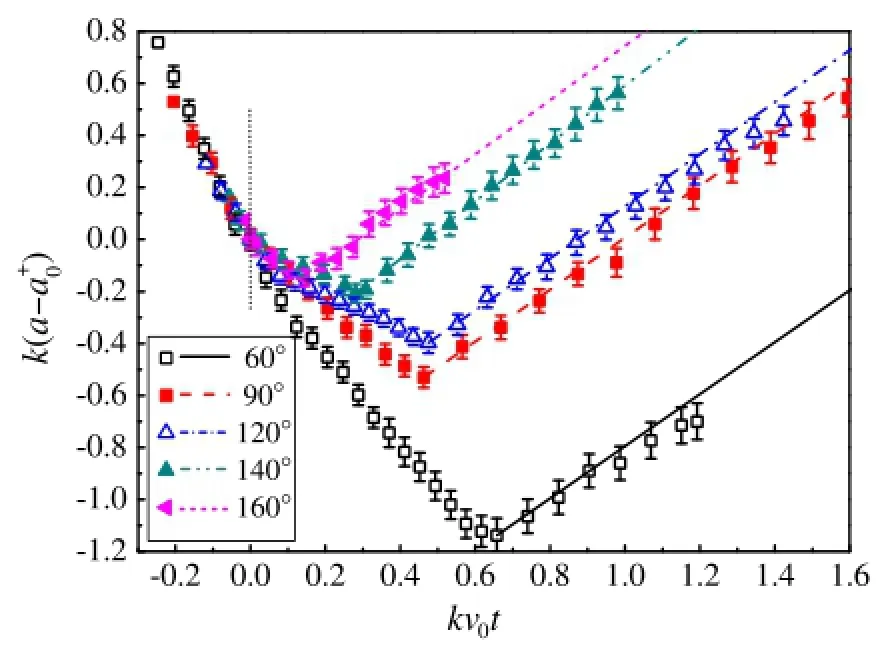
Fig.4.(Coloronline)Comparison ofmixing width extracted from the experimental results with the revised MB model[16]with specific reduction factor listed in Table 2 after the phase reversal.
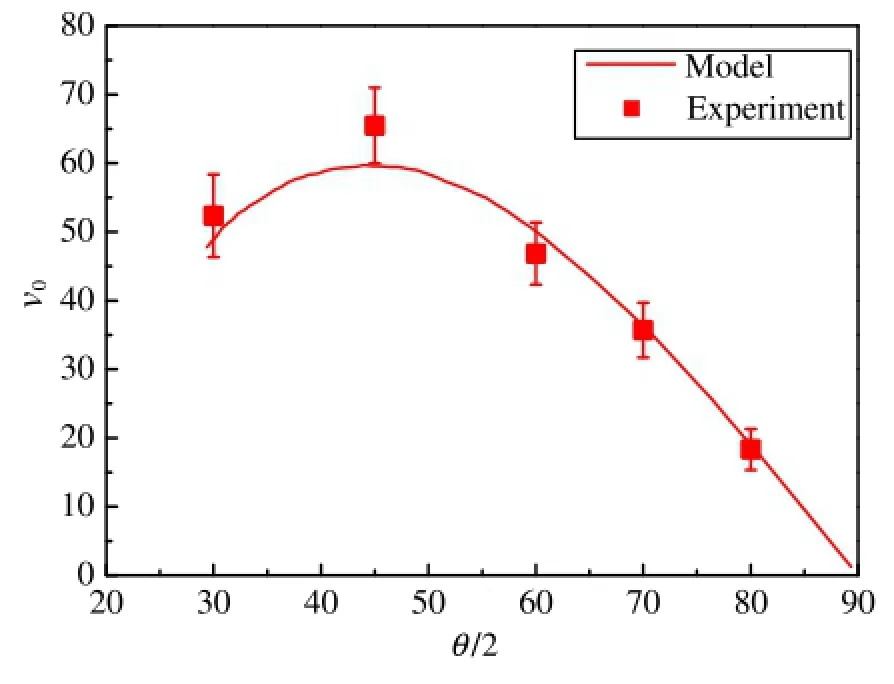
Fig.5.Variation of interface width growth rate with initial amplitude from experiment(symbols)and theory(line).
The Richtmyer-Meshkov instability of a discontinuous'V' shaped air/helium interface is studied experimentally using the soap film technique to create the initial interface.The interface formed is free of support and is discontinuous such that the initialconditions can be accurately controlled.Morphologies ofthe shocked'V'shaped air/helium interface for five different vertex angles are recorded by a high-speed schlieren photography and the effects ofinitialinterface amplitude over wavelength on the mixing width are highlighted.
After the shock impact,a spike forms,and then phase reversal, a specific phenomenon for a heavy/light interface configuration, occurs.For smallvertex angles,more vorticity is produced on the interface,resulting in the obvious vortices generation,and the spike is more noticeable.After phase reversal,the initial linear growth rates ofwidth are experimentally measured and compared with the predictions fromthe linear model.The predictions deviate from the experimental results,especially for large vertex angles, which is ascribed to the high initial amplitudes.Considering the reduction factor,a revised linear model can predict the width linear growth rate of interface with high initial amplitudes. The experimental and theoretical results also reveal the nonmonotonicity between the linear growth rate and the vertex angle,which is for the first time found in a heavy/light interface configuration.
Acknowledgment
This work was supported by the National Natural Science Foundation of China(U1530103,11302219,and 11272308).
[1]R.D.Richtmyer,Taylor instability in shock acceleration ofcompressible fluids, Comm.Pure Appl.Math.13(1960)297-319.
[2]E.E.Meshkov,Instability of the interface of two gases accelerated by a shock wave,Fluid Dyn.4(1969)101-104.
[3]J.D.Lindl,O.Landen,J.Edwards,etal.,Review ofthe nationalignition campaign 2009-2012,Phys.Plasmas 21(2014)020501.
[4]J.Yang,T.Kubota,E.E.Zukoski,A model for characterization of a vortex pair formed by shock passage over a light-gas inhomogeneity,J.Fluid Mech.258 (1994)217-244.
[5]A.M.Abd-el Fattah,L.F.Henderson,Shock waves at a fast-slow gas interface, J.Fluid Mech.86(1978)15-32.
[6]A.M.Abd-el Fattah,L.F.Henderson,Shock waves at a slow-fast gas interface, J.Fluid Mech.89(1978)79-95.
[7]S.M.Bakhrakh,B.A.Klopov,E.E.Meshkov,etal.,Developmentofperturbations ofa shock-accelerated interface between two gases,J.Appl.Mech.Tech.Phy. 36(1995)341-346.
[8]T.Wang,J.H.Liu,J.S.Bai,et al.,Experimental and numerical investigation of inclined air/SF6interface instability under shock wave,Appl.Math.Mech.33 (2012)37-50.
[9]J.A.McFarland,D.Reilly,S.Creel,et al.,Experimental investigation of the inclined interface Richtmyer-Meshkov instability before and after reshock, Exp.Fluids 55(2014)1640-1653.
[10]J.A.McFarland,D.Reilly,W.Black,et al.,Modal interactions between a large-wavelength inclined interface and small-wavelength multimode perturbations in a Richtmyer-Meshkov instability,Phys.Rev.E 92(2015) 013023.
[11]D.Reilly,J.A.McFarland,M.Mohaghar,et al.,The effects of initial conditions and circulation deposition on the inclined-interface reshocked Richtmyer-Meshkov instability,Exp.Fluids 56(2015)168-183.
[12]X.Luo,P.Dong,T.Si,et al.,The Richtmyer-Meshkov instability of a'V'shaped air/SF6interface,J.Fluid Mech.802(2016)186-202.
[13]Z.Dell,R.F.Stellingwerf,S.I.Abarzhi,Effectofinitialperturbation amplitude on Richtmyer-Meshkov flows induced by strong shocks,Phys.Plasmas 22(2015) 092711.
[14]Z.Zhai,M.Wang,T.Si,et al.,On the interaction ofa planar shock with a light polygonalinterface,J.Fluid Mech.757(2014)800-816.
[15]K.A.Meyer,P.J.Blewett,Numerical investigation of the stability of a shockaccelerated interface between two fluids,Phys.Fluids 15(1972)753-759.
[16]A.Rikanati,D.Oron,O.Sadot,et al.,High initial amplitude and high Mach number effects on the evolution of the single-mode Richtmyer-Meshkov instability,Phys.Rev.E 67(2003)026307.
?Corresponding author.Fax:+86 551 63606459.
E-mail address:sanjing@ustc.edu.cn(Z.Zhai).
http://dx.doi.org/10.1016/j.taml.2016.06.002
2095-0349/?2016 The Authors.Published by Elsevier Ltd on behalfof The Chinese Society of Theoreticaland Applied Mechanics.This is an open access article under the CC BY-NC-ND license(http://creativecommons.org/licenses/by-nc-nd/4.0/).
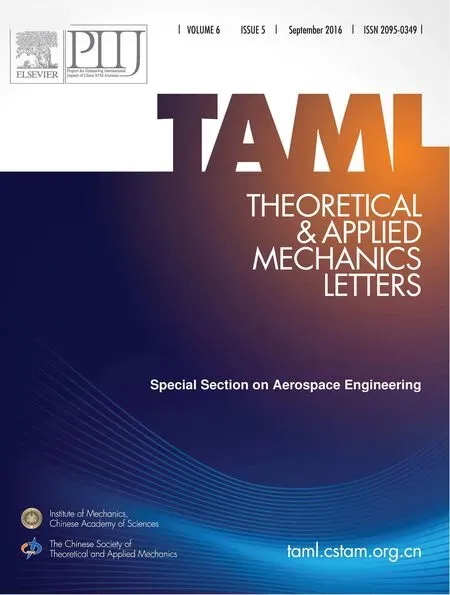 Theoretical & Applied Mechanics Letters2016年5期
Theoretical & Applied Mechanics Letters2016年5期
- Theoretical & Applied Mechanics Letters的其它文章
- A modified airfoil-based piezoaeroelastic energy harvester with double plunge degrees of freedom
- The performance of proper orthogonaldecomposition in discontinuous flows
- A new algorithm ofglobaltightly-coupled transient heat transfer based on quasi-steady flow to the conjugate heat transfer problem
- Side force controlon slender body by self-excited oscillation flag
- High temperature effects in moving shock reflection with protruding Mach stem
- Numericalinvestigation of unsteady mixing mechanism in plate film cooling
